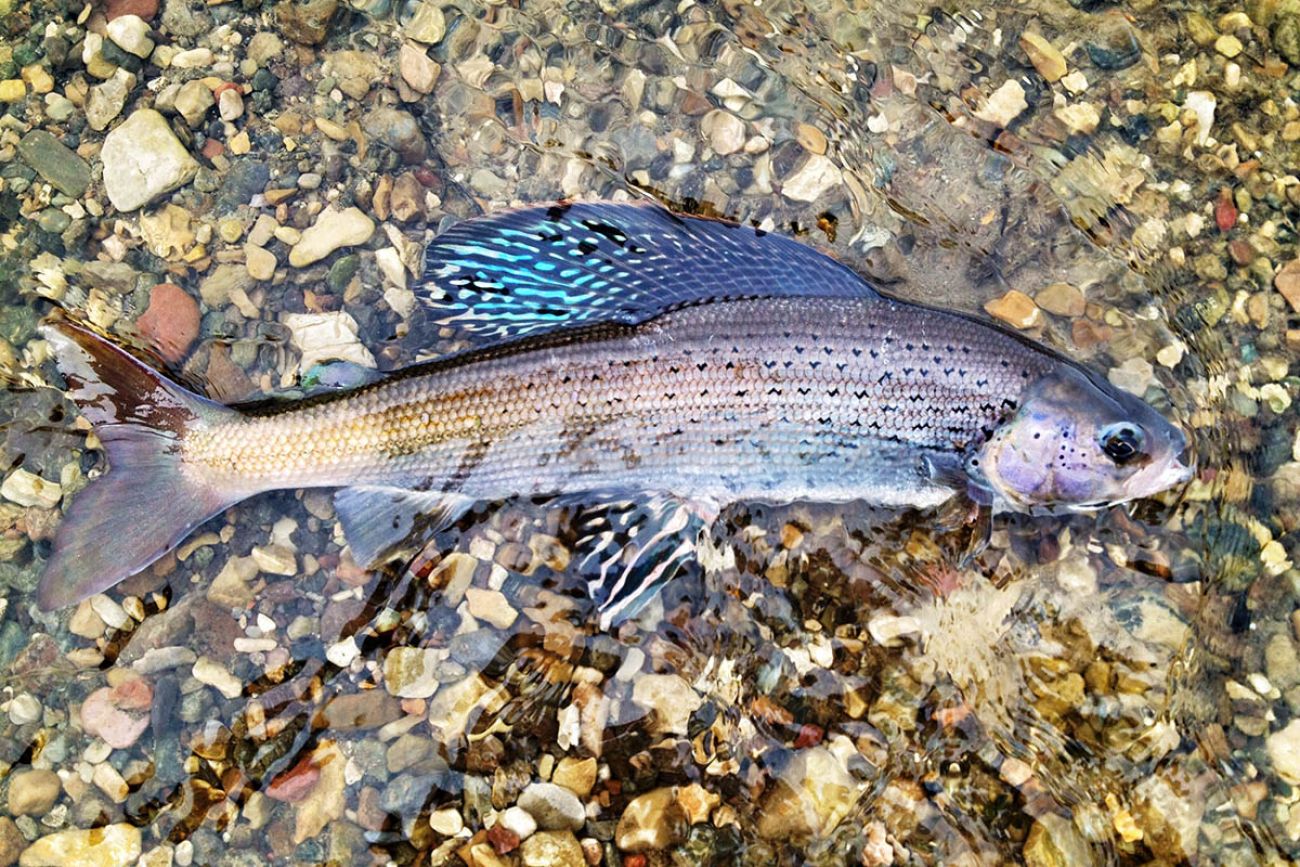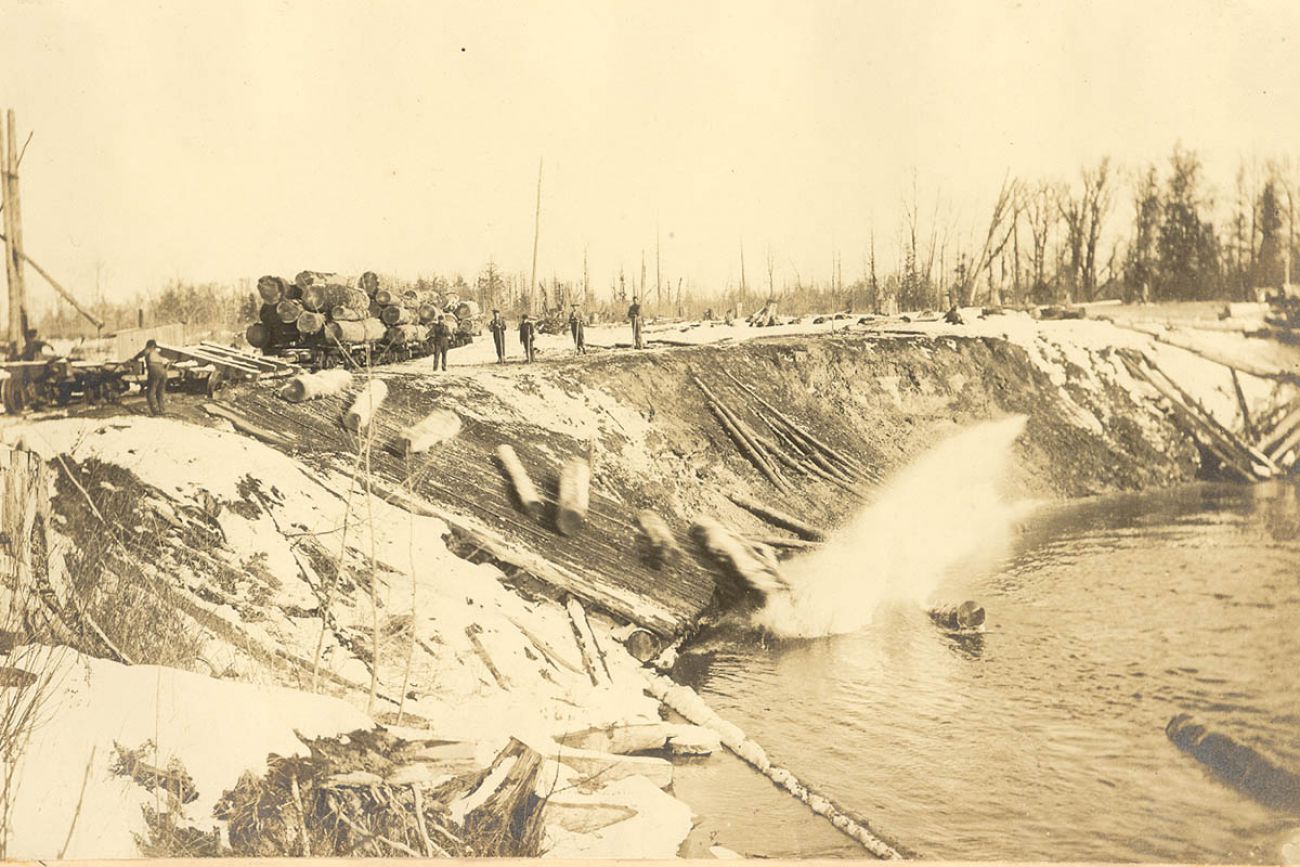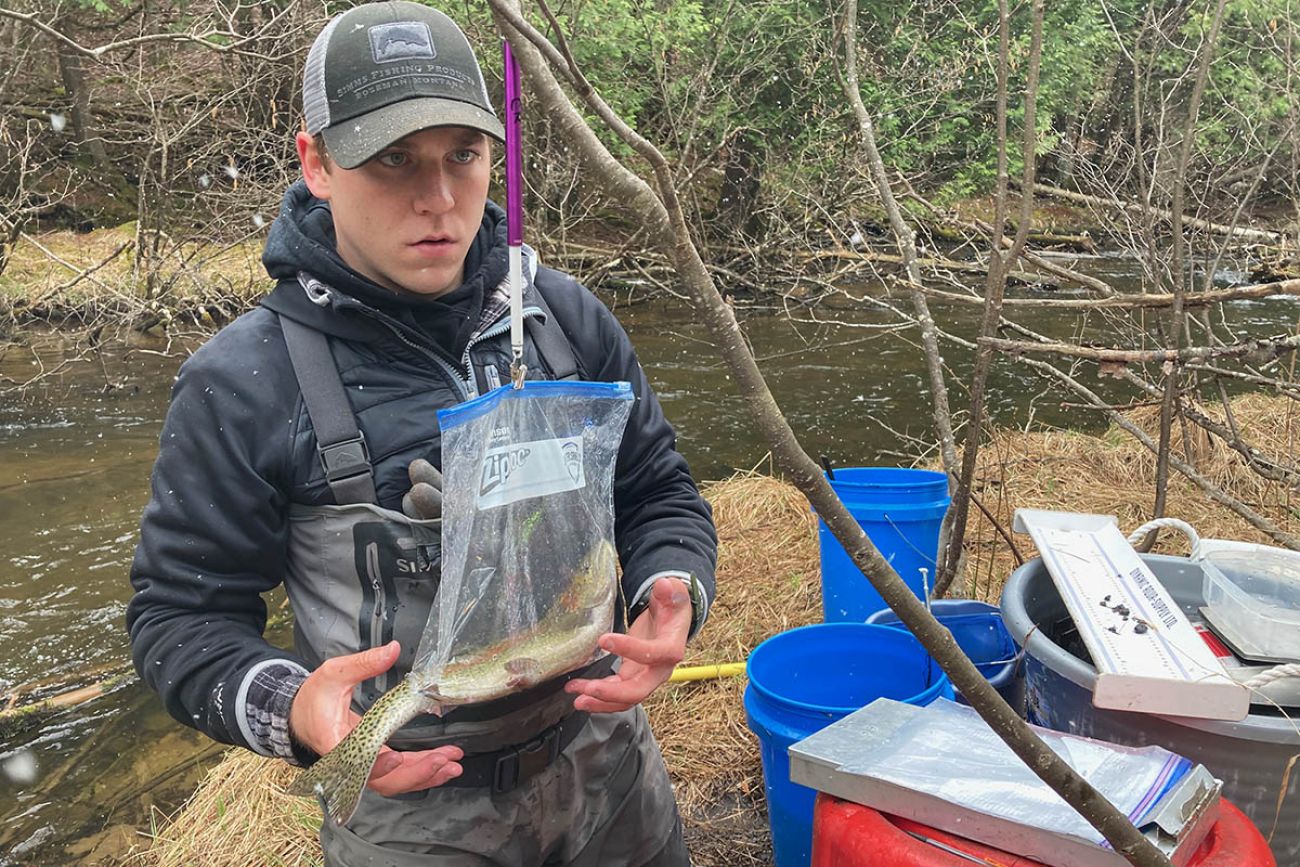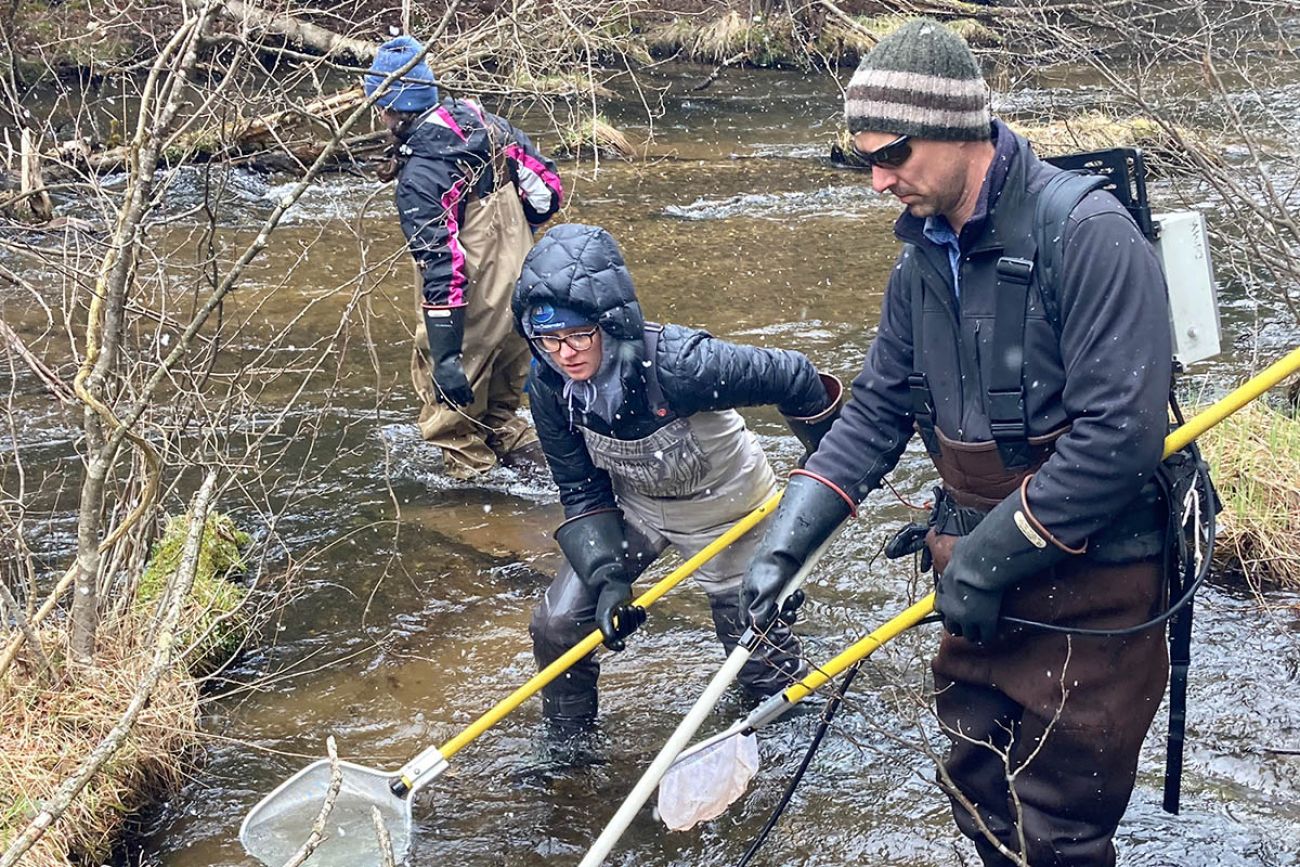Michigan aims to revive Arctic grayling. But first, where to put them?

- Michigan’s arctic grayling vanished in the 1930s from logging, overfishing and competition from non-native species
- Scientists now believe they can successfully return the fish into northern streams
- But deciding where to put the fish is as much about politics as science
MARQUETTE — Dan Sampson flicks on a single light in a darkened room at the Marquette State Fish Hatchery, illuminating a concrete raceway full of fish that began life three years earlier as artificially inseminated eggs in Alaska.
The Arctic grayling’s skin, an iridescent silvery-blue in the wild, has turned white to blend into the water-filled concrete bays — a natural defense mechanism that reflects their unnatural surroundings.
Considerable time has been invested in their survival: A cross-continental plane flight packed on ice; a year-and-a-half quarantine at a Michigan Department of Natural Resources hatchery in Emmet County, followed by 23 months of care and feeding here in Marquette.
Related:
- Michigan works to expand hunting, fishing beyond old white men
- Michigan anglers fear fishing deal with tribes could hurt their interests
- Michigan: Reduce size limit for northern pike in some lakes
If all goes right in this tightly-controlled environment, the translucent fish that swim here could reproduce by 2025, their fertilized eggs becoming the first Arctic grayling to hatch into Michigan waters since the 1930s.

“The thought of it is totally exciting,” said Sampson, who manages the DNR’s northern Michigan hatcheries.
But a key hurdle remains in the effort to revive grayling in the rivers where their relatives swam for millennia before logging and fishing practices wiped them out: Where to put the fish.
The grayling need cold, clear water, with few dams to obstruct their movement, plenty of insects for food, and limited competition from trout and other non-native fish that now dominate Michigan’s northern rivers. And, importantly, they need tolerance from humans who have grown used to a world without them.

Scientists are optimistic, but there are no guarantees.
The fallen kings of Michigan rivers
Native only to arctic Canada and the U.S. states of Michigan, Alaska and Montana, Arctic grayling were once king of the rivers in Michigan’s northern Lower Peninsula.
The Au Sable River’s then-thriving population inspired European settlers in the 1870s to name an entire town after the iridescent fish with its iconic large dorsal fin.
“There are stories of fish being loaded into rail cars and shipped down to Chicago for food,” said Todd Grischke, assistant chief of the DNR Fisheries Division. “Stories of waters dark brown or black, thick with grayling in them.”
But it didn’t last long. The settlers aggressively logged Northern Michigan’s towering white pine and hemlocks, using the rivers as sluiceways to transport logs to sawmills. Formerly clear, cold waters shaded by ancient forests became hot, bare-banked and choked with debris, displacing grayling and destroying their spring breeding beds.

This photo, taken along the Manistee River, shows a typical timber harvesting practice in the late 1800s, in which waterways were used to transport logs to mills, disrupting Arctic grayling breeding grounds. (Photo courtesy of Traverse Area District Library Local History Collection)
“This entire region was lost completely,” said Brett Fessell, an ecologist who leads river restoration efforts for the Grand Traverse Band of Ottawa and Chippewa Indians, one of dozens of partners involved in the grayling reintroduction effort.
Overfishing further diminished struggling grayling populations. To compensate, species managers introduced new fish for anglers to target: Brown trout native to Europe and Asia, brook trout once found primarily in the the Upper Peninsula, and rainbows from California.
“All those different species successfully took to the streams,” said the DNR’s Grischke, “but what that did is it created new competition for anything that was native,” such as the grayling.
By 1936, grayling had disappeared. Many of today’s Michiganders associate brookies, browns and rainbows with the quintessential Up North river. But for Native Americans who evolved alongside the iconic fish, the absence has been felt for generations.
“Those are our family members, our relatives,” said Kira Davis, a member of the Grand Traverse Band and project manager at the National Parks Conservation Association.
Davis sees the effort to revive the species as a story of redemption not unlike that of the tribes themselves.
“Tribal nations also were almost completely killed off,” she said. “That fish has a right to be back in its native habitat just as we do.”
Michigan’s latest effort, initiated by the Little River Band of Ottawa Indians and involving multiple Native American tribes, fits with a broader tribal ethos of prioritizing native species, said Archie Martell, fisheries division manager for the Little River Band.
The fish, whose Anishinaabek name is nmégos, were once an important food for Michigan’s northern tribes. And just as importantly, they were part of a broader native species community that’s fundamental to tribes’ cultural identity.
“Being able to make that reconnection to that species, to the land, to Mother Earth, is something that is important to tribal culture,” Martell said.
And if successful, said the DNR’s Grischke, the grayling’s return could produce a lucrative recreational fishery, making Michigan one of few places in the country where anglers could target the salmonid.
Previous attempts have failed.
But those involved in the latest effort, launched in 2016 by the Little River Band and the DNR, say it benefits from new techniques and a better understanding of what the fish need to survive.
Past efforts treated grayling little differently than the trout already being stocked in Michigan streams: They were reared in hatcheries, then transplanted into rivers as young fish. But by then, scientists say now, it was too late for grayling to “imprint,” or develop an instinctual memory, of the birthstream where they return to spawn as adults.
Lacking that instinct, they failed to reproduce.
Michigan’s new effort borrows a technique from Montana, where species managers successfully introduced grayling by piping water into streamside buckets containing fertilized eggs. When the eggs hatch, Grischke said, they spill out of the bucket and into the stream, “and they’re immediately imprinted.”
The politics of brown trout
The technique increases Michigan’s odds of reviving a population that is naturally reproducing, rather than one that must be restocked year after year. But finding safe launch sites remains a challenge. Scientists still need to find waterways where the fish can survive to reproductive age.
They’re studying the Upper Manistee, Boardman, Jordan, Maple and Au Sable, five watersheds north of M-55 in the forested fingers of the mitten: The streams must be cold and clear, well-shaded, with ample habitat, minimal competition and plenty of food, and likely to stay that way despite climate change that is warming Michigan’s rivers.
In many ways, Michigan’s northern streams are healthier than they’ve been in decades. Landmark environmental laws in the 1960s and 70s cut down on industrial pollution, and efforts to remove dams and replant forests have helped keep water temperatures down.
Climate change will offset some of those gains, but copious quantities of cold springwater make Michigan’s northern rivers more resilient than most.
And though grayling fare best in cold water (they prefer less than 61 degrees), they are surprisingly resilient to heat, said Nicole Watson, a U.S. Bureau of Land Management bish biologist who has studied grayling as a PhD student at Michigan State University. They can survive in temperatures up to the mid-80s.
Competition from brown trout may be a bigger challenge. “They will readily outcompete other species of fish in streams,” Watson said, “including grayling.”
Brown trout have survived on every continent but Antartica in part because they’re voracious predators that edge out other fish in pursuit of food, and frequently devour the competition, too. And they’re found in rivers across Northern Michigan, leaving comparatively few niches where Arctic grayling might thrive.
And there’s one more thing the fish will need to thrive: tolerance from humans.
While the grayling effort has widespread support, it also has some prominent detractors.
The board of Upper Black River Council — a conservation group — signaled in 2017 it wants no part in the grayling reintroduction, fearing the fish could compete with the far northeast Lower Peninsula river’s brook trout.
And the Michigan United Conservation Clubs, Michigan’s largest statewide conservation group with more than 40,000 members, passed a resolution in 2018 expressing a host of concerns about grayling reintroduction.
The group worries a focus on grayling could divert attention from other fish conservation priorities, with no guarantee it will succeed. And if the effort does succeed, said Nick Green, the group’s communications director, MUCC is concerned that sportfishers could one day be asked to adjust their habits to protect fragile grayling populations, such as by limiting fishing in areas where grayling are present.
“The state is going to have to decide what’s more important,” Green said, “the recreational angling on that stretch of stream, or the reintroduction of grayling.”
While MUCC has stopped short of opposing the grayling reintroduction effort, it said reintroduction should only happen in rivers where local anglers support it, and only if it doesn’t siphon time or money from Michigan’s other fisheries programs.
DNR officials say they’re already meeting those bars: Save for a $25,000 state seed grant, the $1.2 million reintroduction effort has been funded with private grants and donations, Grischke said. The DNR will only consider planting grayling in streams where there is local support, he said, and there are no plans to adjust management of popular sportfish like trout for the sake of grayling.
But tribal resource managers believe such interventions should be on the table if needed. They argue that Michigan has plenty of brown trout streams to justify managing a handful of river reaches specifically for Grayling.
“We're not out there wanting to just completely get rid of any species that is not native,” said Fessell, of the Grand Traverse Band. But there may be scenarios, he said, “where there’s going to have to be some management of brown trout.”
Bryan Burroughs sits somewhere in the middle of Michigan’s grayling debate. The executive director of Michigan Trout Unlimited said he sees the value in reviving Michigan’s grayling. But threats from climate change to invasive species are already hammering the state’s existing fish communities.
“If we’re not hanging on to what we have, should we be reintroducing fish to bring the past back?” Burroughs asked. “A lot of people would say absolutely. I would say, I don't know.”
Expect more of these ethical and political debates to play out in Michigan and around the globe as climate change and other challenges continue to strain ecosystems, said Dana Infante, a Michigan State University professor who researches river ecology.
Whether it succeeds or fails, Infante predicted, Michigan’s grayling experiment will provide insights into the kind of human intervention that will become increasingly common.
"This is absolutely going to crop up in other systems, for species that are range restricted or rare or threatened in some other ways,” Infante said. “We're going to have to be creative about how we conserve these organisms."
Searching for the sweet spot
Fessell, the ecologist with the Grand Traverse Band, and his team hope the Boardman River watershed could be the biological and political sweet spot the fish need.

The Boardman, which runs from east of Kalkaska to Traverse City, contains the brown trout that threaten grayling. But their numbers are manageable, Fessell said. And because brown trout prefer slightly warmer water, recent dam removal efforts that have lowered water temperatures in the Boardman give an advantage to fish adapted to colder water, like brook trout and grayling.
Perhaps more importantly, Fessell said, the upper river’s absence of salmon and steelhead makes it less popular among sportfishers than parts of the Au Sable and Manistee, reducing the odds that anglers will oppose grayling reintroduction.
“There wouldn't be a large clamoring of sport fishermen who would advocate for keeping the status quo,” Fessell said.
Martell, of the Little River Band, and Doug Craven, of the Little Traverse Bay Band, said they see promise in stretches of the Upper Manistee and Maple rivers. Craven believes reviving grayling could also bring secondary benefits, including improved management of surrounding land and water to benefit a host of species.
“For Grayling to be present in the Maple River, you really need to have the right temperature regime,” Craven said. “In order to have the right temperature regime in the water, then you really need to have the right riparian (tree) cover. So now we're talking about forestry management and employing better practices there.”
On a snowy April afternoon, Fessell and his team waded through the icy waters of a Boardman tributary, searching for a stretch with ample insects for grayling to eat, and minimal brown trout to eat the grayling.
Biologist Dan Mays dipped a wandlike apparatus into the stream, transmitting electric currents from a battery pack strapped to his back, while his teammates used nets to pull stunned fish from the water.

They turned up a handful of species, including several browns. It was one of 16 sites along the Boardman surveyed for their suitability. The research team identified four as potential candidates for grayling reintroduction.
“We're at a point here, sort of unprecedented through time since (European) settlement,” Fessell said. “We've got systems that are really coming back healthy, resilient systems where grayling could return.”
Grischke, of the DNR, said the agency won’t choose locations for the reintroduction experiment until studies are completed on the Boardman, Upper Manistee, Jordan, Maple and Au Sable — a task that will take a couple of years.
Once the grayling hatch into the agency’s chosen streams, it will take years more for the fish to reach maturity. Successful reproduction will be a tentative sign of the experiment’s success.
Michigan Environment Watch
Michigan Environment Watch examines how public policy, industry, and other factors interact with the state’s trove of natural resources.
- See full coverage
- Subscribe
- Share tips and questions with Bridge environment reporter Kelly House
Michigan Environment Watch is made possible by generous financial support from:
Our generous Environment Watch underwriters encourage Bridge Michigan readers to also support civic journalism by becoming Bridge members. Please consider joining today.
See what new members are saying about why they donated to Bridge Michigan:
- “In order for this information to be accurate and unbiased it must be underwritten by its readers, not by special interests.” - Larry S.
- “Not many other media sources report on the topics Bridge does.” - Susan B.
- “Your journalism is outstanding and rare these days.” - Mark S.
If you want to ensure the future of nonpartisan, nonprofit Michigan journalism, please become a member today. You, too, will be asked why you donated and maybe we'll feature your quote next time!






